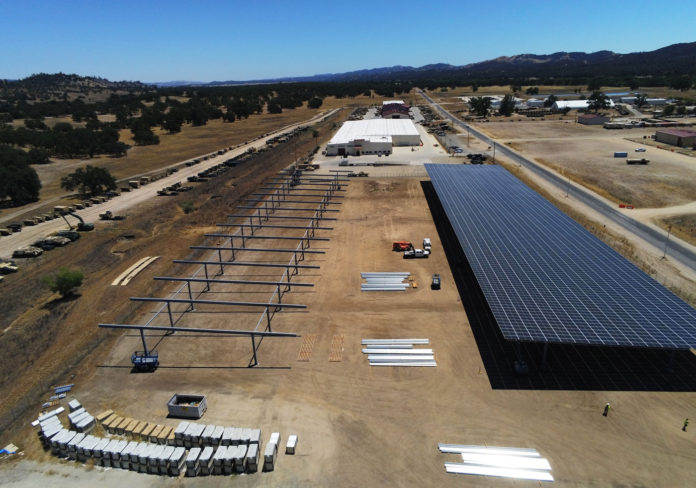JOLON — Fort Hunter Liggett (FHL) continues to lead the way in the Army’s energy resilience as the first-ever military installation with a microgrid implementation using only renewable sources, such as photovoltaic (PV) generation and battery storage.
The Army Reserve-funded installation is very close to becoming a Net Zero installation and is on track to achieve target year of 2030, which is ahead of the Executive Order 14057 (Catalyzing Clean Energy Industries and Jobs Through Federal Sustainability) goal of 2045.
FHL was the only U.S. Army site featured in the July 2021 White House Sustainability Showcase for its resiliency planning efforts, infrastructure modernization and resiliency best practices; and also received a Presidential Federal Sustainability Award Honorable mention for fiscal year 2023.
“Our microgrid system is unique in that most other microgrids being implemented by the Department of Defense has some carbon-based fuel asset,” said Jarrod Ross, FHL Resource Efficiency Manager. “Thanks to our on-site renewable energy sources, we eliminate the supply disruption risks associated with fossil fuels during natural disasters when they become unavailable. This is critical in high-risk climate areas, such as California, and why the Army has invested more than $100 million in FHL’s resilience and security initiatives since 2012.”
This journey began in 2008, when the FHL energy manager at the time attended GOVEnergy workshop (now known as Energy Exchange) and learned about the exciting energy-resilience initiatives by other federal agencies.
“Energy access is essential for resilience, meaning, if our energy supply is disrupted, we still have the power needed to mobilize, deploy and win. From the electricity that powers our facilities to the fuel that powers our vehicles, energy touches nearly every aspect of the Army Reserve’s mission,” said Col. Stephen Trotter, FHL garrison commander.
In 2011, FHL was designated as an Army Net Zero (NZ) Energy and Waste pilot installation — creating a strategic path leading to the 2024 microgrid commissioning. “Net Zero” is the Army’s goal to manage resources in a sustainable manner and is a holistic approach to addressing energy, water and waste. A NZ Energy site will produce as much energy as it consumes over the course of one year through energy conservation efforts, energy efficient practices, energy recovery projects and renewable technologies.
As a NZ Energy and Waste pilot site, FHL developed a framework for guiding energy and water initiatives by participating in the Army’s Integrated Strategic and Sustainability Planning (ISSP) process to develop a long-term (15-25 years) holistic strategic plan for infrastructure, training and partnerships.
FHL was also the first Army Reserve-funded installation to have an approved Installation Energy and Water Plan (IEWP) — providing a roadmap for achieving increased security, resilience, readiness and mission assurance for a five-year planning horizon of energy and water management at both FHL and its sub-installation, Parks Reserve Forces Training Area, located in Dublin, Calif.
In the past decade, FHL reduced its energy use intensity by 63% with a combination of traditional energy efficiency projects, installation of geothermal and air-source heat pump systems for heating, ventilation and air-conditioning (HVAC) and domestic hot water (DHW) applications to reduce its fossil fuel use, installing advanced utility meters, and setting up an Integrated Installation Controls Center (I2C2) to manage energy demand and delivery during normal and contingency operations.
A legacy of resilience and sustainable progress
In addition to energy, water efficiency and resilience projects are a priority at FHL. A new secondary wastewater treatment facility was installed in 2024. The system enables the installation to reuse treated wastewater for use in non-potable applications, enabling its facilities to remain operational during times of disruption, especially during the California wildfire season.
FHL’s success has been realized by the unrelenting dedication of a small team from the FHL directorates of Public Works and Resource Management, who understand how to maximize the support and funding available to Army Reserve-funded installations. Individual contributors were empowered to succeed by supportive and forward-thinking leaders willing to take risk and make change happen.
Beginning with the leadership of Col. Kevin Riedler in 2008, and successive commanders taking the baton, the NZ momentum has not been lost.
“I’m incredibly honored to be part of the final phase of Fort Hunter Liggett reaching its resilience goals,” Trotter said. “The biggest take-away is that this microgrid system enables us to meet the resilience requirement to power critical facilities and support troop training until the local power grid can be restored.”
The $21.8 million microgrid project completion increases FHL’s 3-megawatt (MW) PV generation system (installed 2012-15) with an additional 3.75MW of PV generation, and a 2.5MW/5MWh Battery Energy Storage System. Combined with the upgrade of 13 manageable medium voltage distribution switches, and a Supervisory Control and Data acquisition System (SCADA), this system will give FHL the capability to operate disconnected from PG&E utility for sustained periods of time.
In July, the system was successfully tested and operated in “island-mode” and the next steps are to continue and complete the commissioning process and enter permanent operation.
Key partners and stakeholders that assisted FHL in reaching the completion of the microgrid project include the Army Reserve Installation Management Directorate’s Sustainment and Resiliency Division (SRD), the U.S. Army Corps of Engineers, Pacific Northwest National Laboratory, Lawrence Berkeley National Laboratory, Ameresco and Schweitzer Engineering Laboratories.
FHL will celebrate this historical achievement with a microgrid ribbon-cutting ceremony on Sept. 17.
“The Army Reserve continues to lead the way in energy resilience,” shared Paul Wirt, SRD Chief. “This moment of celebration is built on over a decade’s work — a culmination of multiple initiatives, projects and dedicated personnel that strategically got us where we are today. Because of their achievements, other Army and Army Reserve funded installations will enhance their resilience, and ultimately, their readiness to sustain the mission and our environment.”















